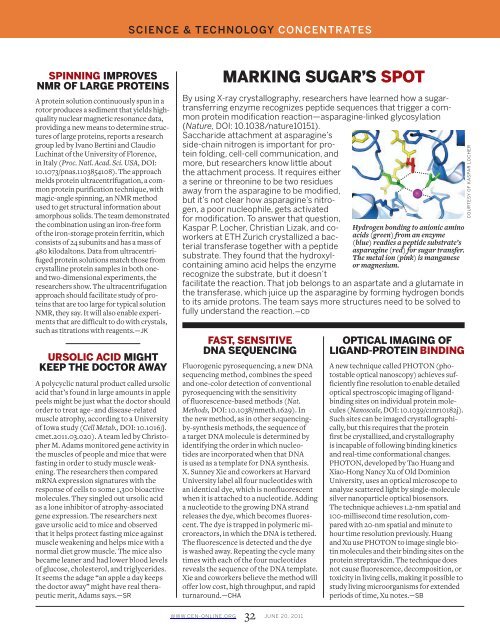June 20, 2011 - IMM@BUCT
June 20, 2011 - IMM@BUCT
June 20, 2011 - IMM@BUCT
You also want an ePaper? Increase the reach of your titles
YUMPU automatically turns print PDFs into web optimized ePapers that Google loves.
SCIENCE & TECHNOLOGY CONCENTRATESSPINNING IMPROVESNMR OF LARGE PROTEINSA protein solution continuously spun in arotor produces a sediment that yields highqualitynuclear magnetic resonance data,providing a new means to determine structuresof large proteins, reports a researchgroup led by Ivano Bertini and ClaudioLuchinat of the University of Florence,in Italy ( Proc. Natl. Acad. Sci. USA, DOI:10.1073/pnas.1103854108). The approachmelds protein ultracentrifugation, a commonprotein purification technique, withmagic-angle spinning, an NMR methodused to get structural information aboutamorphous solids. The team demonstratedthe combination using an iron-free formof the iron-storage protein ferritin, whichconsists of 24 subunits and has a mass of480 kilodaltons. Data from ultracentrifugedprotein solutions match those fromcrystalline protein samples in both oneandtwo-dimensional experiments, theresearchers show. The ultracentrifugationapproach should facilitate study of proteinsthat are too large for typical solutionNMR, they say. It will also enable experimentsthat are difficult to do with crystals,such as titrations with reagents. —JKURSOLIC ACID MIGHTKEEP THE DOCTOR AWAYA polycyclic natural product called ursolicacid that’s found in large amounts in applepeels might be just what the doctor shouldorder to treat age- and disease-relatedmuscle atrophy, according to a Universityof Iowa study ( Cell Metab., DOI: 10.1016/j.cmet.<strong>20</strong>11.03.0<strong>20</strong>). A team led by ChristopherM. Adams monitored gene activity inthe muscles of people and mice that werefasting in order to study muscle weakening.The researchers then comparedmRNA expression signatures with theresponse of cells to some 1,300 bioactivemolecules. They singled out ursolic acidas a lone inhibitor of atrophy-associatedgene expression. The researchers nextgave ursolic acid to mice and observedthat it helps protect fasting mice againstmuscle weakening and helps mice with anormal diet grow muscle. The mice alsobecame leaner and had lower blood levelsof glucose, cholesterol, and triglycerides.It seems the adage “an apple a day keepsthe doctor away” might have real therapeuticmerit, Adams says. —SRMARKING SUGAR’S SPOTBy using X-ray crystallography, researchers have learned how a sugartransferringenzyme recognizes peptide sequences that trigger a commonprotein modification reaction—asparagine-linked glycosylation(Nature, DOI: 10.1038/nature10151).Saccharide attachment at asparagine’sside-chain nitrogen is important for proteinfolding, cell-cell communication, andmore, but researchers know little aboutthe attachment process. It requires eithera serine or threonine to be two residuesaway from the asparagine to be modified,but it’s not clear how asparagine’s nitrogen,a poor nucleophile, gets activatedfor modification. To answer that question,Kaspar P. Locher, Christian Lizak, and coworkersat ETH Zurich crystallized a bacterialtransferase together with a peptidesubstrate. They found that the hydroxylcontainingamino acid helps the enzymerecognize the substrate, but it doesn’tFAST, SENSITIVEDNA SEQUENCINGFluorogenic pyrosequencing, a new DNAsequencing method, combines the speedand one-color detection of conventionalpyrosequencing with the sensitivityof fluorescence-based methods ( Nat.Methods, DOI: 10.1038/nmeth.1629). Inthe new method, as in other sequencingby-synthesismethods, the sequence ofa target DNA molecule is determined byidentifying the order in which nucleotidesare incorporated when that DNAis used as a template for DNA synthesis.X. Sunney Xie and coworkers at HarvardUniversity label all four nucleotides withan identical dye, which is nonfluorescentwhen it is attached to a nucleotide. Addinga nucleotide to the growing DNA strandreleases the dye, which becomes fluorescent.The dye is trapped in polymeric microreactors,in which the DNA is tethered.The fluorescence is detected and the dyeis washed away. Repeating the cycle manytimes with each of the four nucleotidesreveals the sequence of the DNA template.Xie and coworkers believe the method willoffer low cost, high throughput, and rapidturnaround.—CHAHydrogen bonding to anionic aminoacids (green) from an enzyme(blue) readies a peptide substrate’sasparagine (red) for sugar transfer.The metal ion (pink) is manganeseor magnesium.facilitate the reaction. That job belongs to an aspartate and a glutamate inthe transferase, which juice up the asparagine by forming hydrogen bondsto its amide protons. The team says more structures need to be solved tofully understand the reaction. —CDOPTICAL IMAGING OFLIGAND-PROTEIN BINDINGA new technique called PHOTON (photostableoptical nanoscopy) achieves sufficientlyfine resolution to enable detailedoptical spectroscopic imaging of ligandbindingsites on individual protein molecules( Nanoscale, DOI: 10.1039/c1nr10182j).Such sites can be imaged crystallographically,but this requires that the proteinfirst be crystallized, and crystallographyis incapable of following binding kineticsand real-time conformational changes.PHOTON, developed by Tao Huang andXiao-Hong Nancy Xu of Old DominionUniversity, uses an optical microscope toanalyze scattered light by single-moleculesilver nanoparticle optical biosensors.The technique achieves 1.2-nm spatial and100-millisecond time resolution, comparedwith <strong>20</strong>-nm spatial and minute tohour time resolution previously. Huangand Xu use PHOTON to image single biotinmolecules and their binding sites on theprotein streptavidin. The technique doesnot cause fluorescence, decomposition, ortoxicity in living cells, making it possible tostudy living microorganisms for extendedperiods of time, Xu notes. —SBCOURTESY OF KASPAR LOCHERWWW.CEN-ONLINE.ORG 32 JUNE <strong>20</strong>, <strong>20</strong>11
















